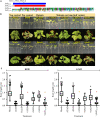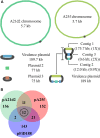Phytopathogenic Rhodococcus Have Diverse Plasmids With Few Conserved Virulence Functions
- PMID: 32523572
- PMCID: PMC7261884
- DOI: 10.3389/fmicb.2020.01022
Phytopathogenic Rhodococcus Have Diverse Plasmids With Few Conserved Virulence Functions
Abstract
Rhodococcus is a genus of Gram-positive bacteria with species that can cause growth deformations to a large number of plant species. This ability to cause disease is hypothesized to be dependent on a cluster of three gene loci on an almost 200 kb-sized linear plasmid. To reevaluate the roles of some of the genes in pathogenicity, we constructed and characterized deletion mutants of fasR and four fas genes. Findings confirmed that fasR, which encodes a putative transcriptional regulator, is necessary for pathogenesis. However, three of the fas genes, implicated in the metabolism of plant growth promoting cytokinins, are dispensable for the ability of the pathogen to cause disease. We also used long-read sequencing technology to generate high quality genome sequences for two phytopathogenic strains in which virulence genes are diverged in sequence and/or hypothesized to have recombined into the chromosome. Surprisingly, findings showed that the two strains carry extremely diverse virulence plasmids. Ortholog clustering identified only 12 genes present on all three virulence plasmids. Rhodococcus requires a small number of horizontally acquired traits to be pathogenic and the transmission of the corresponding genes, via recombination and conjugation, has the potential to rapidly diversify plasmids and bacterial populations.
Keywords: Gram-positive; Rhodococcus; cytokinins; evolution; virulence plasmids.
Copyright © 2020 Savory, Weisberg, Stevens, Creason, Fuller, Pearce and Chang.
Figures




References
LinkOut - more resources
Full Text Sources
Research Materials
Miscellaneous

